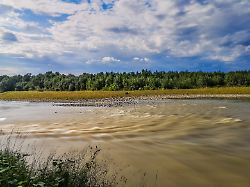Dangerous Romania border
Ukrainians flee through the river of death to the EU
By Kevin Schulte
04.06.2024, 15:58
Listen to article
This audio version was artificially generated. More info | Send feedback
There is a deadly border between Ukraine and Romania. The River Tisza separates the war-torn country from the EU. Ukrainian men cross the river to avoid having to go to the front. Many pay for the escape with their lives.
Since the war began in February 2022, Ukrainian men between the ages of 18 and 60 are no longer allowed to leave their country. At least not legally, because they are needed for service on the front lines. But young Ukrainians in particular are increasingly fleeing. Some of them are trying to swim to the EU: For around 65 kilometers, the Tisza forms a natural border between Ukraine and Romania – the fast current and ice-cold water make the river a life-threatening stream.
Since February 2022, 33 Ukrainians have drowned in the Tisza while trying to swim to Romania. The youngest victim was just 20 years old. The number of unreported drownings is probably much higher. The Ukrainian border guard assumes that a number of bodies have not yet been recovered because they are stuck in the reeds under water and are not floating to the surface.
The 24-year-old engineer Matviy also almost drowned in the Tisza. He and three other comrades recently fled to Romania. They had clearly underestimated the dangers of the river, Matviy reports in the British “Economist”The fast current carried even the best swimmer in the group 200 meters downstream, and two others were swept 400 meters away. “We could hardly breathe. We almost drowned,” Matviy told the magazine.
Smugglers take thousands of euros
For most Ukrainian men, the Tisza is still the easiest way to escape. Despite the dangers, the river has become a popular destination for crossing the border over the past two years. And this despite the fact that the authorities have now started publishing pictures of the drowned as a deterrent. “The growing fear of being drafted and the promise of a better life in Europe” are stronger, the “Economist” summarizes.
In total, almost 2,400 illegal border crossings from Ukraine were recorded via the river and other routes in the first three months of this year, the Romanian side reports. Most illegal border crossings were recorded in the mountainous Transcarpathian region, where a busy smuggling scene had already developed before the war and many people live off duty-free cigarettes, petrol and other things.
Due to the war in Ukraine, petty criminals have expanded their business to include human trafficking services. Such services cost between 3,000 and 12,000 euros, as the “Economist” reports. Matviy, the 24-year-old engineer who swam across the Tisza, paid around 5,000 dollars for the life-threatening trip across the river to Romania, he reports in an interview.
Corruption in recruitment centers
Fear of war or the desire for a peaceful life in the EU is driving many Ukrainian men out of the country. And a feeling of injustice, as one conscientious objector told ntv reporter Kavita Sharma last autumn. “The rich have fled abroad or bought their way out and are sitting in Kiev. Only the poor are at the front,” claims the conscientious objector named Viktor, referring to cases of corruption in the recruitment centers. Men had been discharged by paying bribes, and as a result President Volodymyr Zelenskyy fired the heads of all the recruitment centers.
Zelensky also responded with an initiative to punish corruption in wartime as severely as treason. The regulation is to apply for the duration of the war. No one should even think about accepting bribes. If there is evidence of corruption, a prison sentence must follow, the president demanded. “If corruption in wartime is equated with treason, this can be a very serious tool for not even thinking about becoming corrupt,” Zelensky argued last year.
Refugees are usually stopped before the Tisza
So far, the Ukrainian parliament has not followed the president’s proposal. However, it has now become significantly more complicated to cross the border into the EU. The government in Kiev has sent units of the National Guard to the region and significantly strengthened checkpoints. A spokeswoman for the Ukrainian border guard says that statistically speaking, on average seven out of ten refugees are stopped before they even reach the river.
Under these circumstances, some refugees take the much longer mountain route to Romania with the help of smugglers. Others, however, still swear by the river as the safest and most straightforward way from one country to another. “You just have to know the right places,” a smuggler named Vasyl tells the “Economist,” adding: “I can show you where you can cross the river without getting your balls wet.”
With this knowledge, the traffickers lure conscientious objectors, Ukrainians who are tired of the war or who want to leave the country for other reasons and collect a lot of money. Of course, the Ukrainians have to swim across the river all by themselves – usually under the cover of darkness, when the current of the Tisza is even more dangerous.
“Learned something new” is a podcast for the curious: Why would a ceasefire probably just be a break for Vladimir Putin? Why is NATO afraid of the Suwalki Gap? Why does Russia have iPhones again? What small behavioral changes can save 15 percent of energy? Listen in and become a little smarter three times a week.
You can find all episodes in the ntv app, at RTL+, Amazon Music, Apple Podcasts and Spotify. For all other podcast apps you can use the RSS feed.
Do you have a question? Please send us an email to [email protected]
